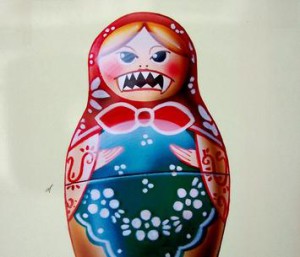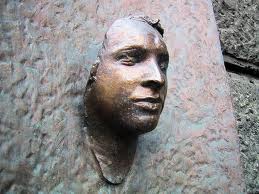Museum of Communism in Prague
By Tracy A. Burns
 Divided into sections named The Dream, The Reality, and The Nightmare, Prague’s Museum of Communism traces the dark history of Communist rule in Czechoslovakia from the Party’s inception in 1921 to the 1989 Velvet Revolution that toppled the regime and brought democracy to the nation. The exhibits form a written and pictorial narrative of the dismal, oppressive days of totalitarian rule. Ironically, the museum was co-founded by an American, Glenn Spicker.
Divided into sections named The Dream, The Reality, and The Nightmare, Prague’s Museum of Communism traces the dark history of Communist rule in Czechoslovakia from the Party’s inception in 1921 to the 1989 Velvet Revolution that toppled the regime and brought democracy to the nation. The exhibits form a written and pictorial narrative of the dismal, oppressive days of totalitarian rule. Ironically, the museum was co-founded by an American, Glenn Spicker.
The Dream
The first part of the exhibition describes why Communism was politically attractive in the first half of the 20th century. It explains how the Communists used the high rate of unemployment during the economic crisis of the 1930s to their advantage in the political and social spheres and the Occupation that began in March of 1939 when the Nazis took over Bohemia and Moravia. The exhibition also emphasizes that the Soviets were the ones to liberate Czechoslovakia at the end of World War II and that the Communist victory in the 1946 elections that gave the Party much control over the press and other areas. The exhibits also deal with Communism’s popularity throughout Europe during the 1950s.
Empty shops and telephone booths lacking phones
Most of the exhibits, though, cover the reality and the nightmare of Communism. Some displays include an almost empty shop with only soup and cocoa on its shelves, a classroom featuring books that children would have read during Communism, and a depressing, starkly furnished interrogation room with a telephone intermittently ringing. There is an old, wooden telephone box without a phone, an absurdity that is reminiscent of the Communists forbidding citizens to give opinions and speak freely. If people voiced comments even gently criticizing the political situation, they could be charged with “instigation or distribution of alarming news.”
Paintings and Pioneers and more
A board with slots for time cards bears the sign, “Timely Arrival to Work Deals the Decisive Strike against the American Aggressors.” A painting shows the first Czechoslovak Communist President, Klement Gottwald, standing next to Soviet Union leader Joseph Stalin. Gottwald is holding a newspaper dominated by the large headline, “Forever with the Soviet Union.” Larger-than-life statues of Karl Marx and Vladimir Ilyich Lenin loom over visitors not far from the entrance. A figure dressed in the uniform of the Pioneers, a Soviet-style youth organization, is on display next to the classroom. Notice the red Communist star on the light blue shirt with a red scarf. In a picture from a demonstration held in the pivotal year of 1989, a woman holds up a sign showing Vaclav Havel and the words, “Brno residents want Havel in the Castle.”
The film
A film is devoted to the history of Communism and its tragic consequences, including footage of police beating protestors during the demonstrations that helped forge the way to freedom. The mournful and poetic protest song criticizing the Communist regime, called “Dekuji” or “Thank you,” performed and authored by singer and songwriter Karel Kryl, plays in the background of the footage showing demonstrations.
The monument to Stalin
Some of the exhibits specifically focus on Prague, taking a close look at the mammoth statue of Stalin that was located in Letna Park, for instance. Built from 1951 to 1955, the 30-meter high creation was planned as a celebration of Stalin’s 70th birthday. Yet Stalin did not live to see the tribute. Even the sculptor did not see the outcome; Otakar Svec killed himself before his work’s May 1, 1955 unveiling. Ironically, Soviet Union leader Nikita Khrushchev denounced Stalin the following year, and a period of “destalinization” followed. Still, the statue was an eyesore at Letna Park until it was destroyed in 1962. Pictures of the statue’s construction and its ceremonial opening are on display.
The slums of central Prague
Another Prague-related theme crops up in a display called “The Devastation of Prague.” While Communists focused on building the statue of Stalin, they neglected to make repairs to downtown Prague, and the historical center became decrepit. The government forced Romany to live in the slums that had great historical value.
North Bohemia’s devastation and propaganda against capitalism
The displays reveal some intriguing facts. As an example of the harmful industrialization under totalitarian rule, a panel highlights the situation in North Bohemia, where surface mining destroyed the land and polluted the air. Another section explains that, although the United States was the main target of the propaganda against capitalism, many citizens were not duped. The Communists even asserted that a potato bug in the fields was caused by American saboteurs who had unleashed the insects from airplanes flown over the country. More captivating information involves the Communist Party distrusting the ice hockey players who had won gold medals at two World Championships before the totalitarian rule. These athletes were victims of show trials that resulted in lengthy prison sentences.
The show trials and Rudolf Slansky
Texts in the Interrogation Room describe the show trials from 1948 to 1954, highlighting the process involving high-ranking Communist Rudolf Slansky in 1952. Slansky was wrongly charged with espionage along with 13 others. He and 10 more of the accused received death sentences. Their ashes were dumped at a construction site near Prague.
Other eras featured in exhibits
 Other periods featured include the liberal reforms instigated by Czechoslovak First Secretary Alexander Dubcek and the crushing of those reforms when Soviet tanks invaded Prague. The exhibit then shows the result of the invasion – the Normalization era that adhered to rigid rules orchestrated by Communist hard-liners. The self-immolation of Czech student Jan Palach plus Mikhail Gorbachev’s stress on openness and glasnost also gives historical contexts to those respective eras.
Other periods featured include the liberal reforms instigated by Czechoslovak First Secretary Alexander Dubcek and the crushing of those reforms when Soviet tanks invaded Prague. The exhibit then shows the result of the invasion – the Normalization era that adhered to rigid rules orchestrated by Communist hard-liners. The self-immolation of Czech student Jan Palach plus Mikhail Gorbachev’s stress on openness and glasnost also gives historical contexts to those respective eras.
Opening times and ticket prices
The Museum of Communism is open seven days a week, including holidays except for December 24, from 9 am to 9 pm. It is situated in Savarin Palace at Na Prikope 10, on the first floor above a Mcdonald’s and neighboring a casino. Tickets cost 190 Czech crowns for adults and 150 Czech crowns for students. Children aged 10 and under can enter the museum free of charge.




